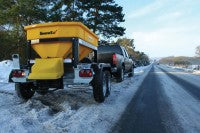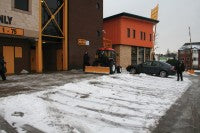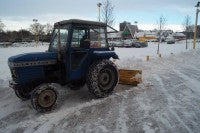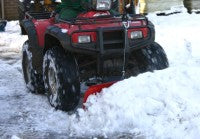Cover your ice!
 Increasingly, landscaping and groundcare professionals are extending their services into the off-season to include snow and ice management. Seasoned professionals and newcomers alike do it to grow profits and cover their bottom line, but too many forget to cover their bases when it comes to liability issues. They provide winter maintenance services to reduce their clients' risk, but may not realise that, in a slip-and-fall claim, the blame can fall on them.
Increasingly, landscaping and groundcare professionals are extending their services into the off-season to include snow and ice management. Seasoned professionals and newcomers alike do it to grow profits and cover their bottom line, but too many forget to cover their bases when it comes to liability issues. They provide winter maintenance services to reduce their clients' risk, but may not realise that, in a slip-and-fall claim, the blame can fall on them.
With the advent of the 'claims-for-everything' culture and two recent hard winters, the number of slip-and-fall claims can be expected to rise as well, and solicitors, typically, won't stop with your client when looking for compensation.
Lawsuits and claims can easily ruin a business, especially when gambling with liability in the high stakes of snow and ice management. This is why contractors must insure themselves and take steps to reduce their liability exposure.
Going Under Cover!
When entering the snow and ice management business, the first step a contractor must take to protect against liability is to investigate his current insurance policy. As obvious as this may seem, many don't realise that their current general liability policy may not cover snow and ice management services. They must meet with their insurance agent to discuss cover on new business plans, but also read through the insurance policy themselves. Whether trusted or not, the agent is ultimately a salesperson and may not know all the right answers.
 The amount of cover needed depends largely on the size of an operation, but other factors come into play as well. Contractors must consider their clients because many commercial facilities require them to carry a certain amount of liability insurance. Typically, these clients stipulate between £1 million and £3 million worth of coverage. To help meet the demands, umbrella policies can supplement the general liability insurance.
The amount of cover needed depends largely on the size of an operation, but other factors come into play as well. Contractors must consider their clients because many commercial facilities require them to carry a certain amount of liability insurance. Typically, these clients stipulate between £1 million and £3 million worth of coverage. To help meet the demands, umbrella policies can supplement the general liability insurance.
As with any insurance policy, nobody hopes to ever use it. However, any snow and ice management contractor is apt to receive a slip-and-fall claim if he is in the business long enough. To further protect himself in this situation, a contractor must combine his cover with preventative measures to reduce his liability exposure. By doing so, he can help prove due diligence in his efforts, and not negligence.
Choosing Your Words Carefully
Crucial to reducing liability, service agreements spell out the responsibilities of a contractor, and nothing should be left out. A contractor must explain all services to his clients and then have them sign off on what they accept, what they reject and any further special instructions.
Contracts must also clearly identify the party responsible for de-icing, because some clients may request to de-ice their own pedestrian areas and entrance ways. If this isn't noted, the client may try to blame his own negligence on the contractor in the case of a slip-and-fall incident.
Another de-icing issue that is often left out of contracts is freeze-thaw cycles, where areas that are treated in the early morning will thaw, but then freeze again at the end of a very cold day. The freeze-thaw cycles create icy spots that need to be managed. The agreement should state whether the client is responsible for notifying the contractor of these hazards or if the contractor must keep watch.
Wording also plays a vital role in a contractor's agreements, both in his own and the ones he signs. A legal advisor should review them, as this can help identify language, even if it's just a single word, in a contract that can cause trouble. As an example, contracts should use the word "serviced" instead of "cleared" because, in an ongoing event, one may not be able to keep all properties completely cleared. Also, the word "insured" works better than "fully-insured" since nobody can say how much insurance is really enough, and solicitors will jump at the chance to find out in a claim case.
When signing clients' contracts, one must use caution. Many contractors, desperate for new business, sign them without considering the consequences. This may expose them to excess liability, since outside contracts are often generated by large national clients and contain generic language.
As an example, a contract may state that the contractor is responsible for slip-and-fall occurrences on the client's property. However, a better contract would be more specific, so the contractor could not be held responsible for areas on the property that he is not instructed to service, such as entranceways.
Additionally, outside contracts often put the client in charge of service frequencies. This takes control away from the contractor, who may be on a busy schedule when the client calls for service. When he does arrive at the client's premises the snow may be packed down, making it harder to clear and requiring more material to melt the ice.
Putting Everything in Writing
Other than service agreements, more paperwork is needed. For every job a contractor should document the time he arrived at the site, how many square feet/metres he treated, the services he provided, the products he used and the weather conditions at the time he serviced the property. All of these factors are important because these are the questions a solicitor asks in a slip-and-fall case. If the contractor can prove that the property was serviced in a timely manner, the appropriate volume and type of ice melt was used, and the service agreement was fulfilled, a court of law is likely to find that he exercised due diligence and is free of liability.

Furthermore, a contractor should take photos of all clients' premises before snow starts to fall because, not only are pictures worth a thousand words, they can also save thousands of pounds. They help identify obstacles on the maintained area and act as documentation of prior property damage. For example, a client may have a damaged kerb that he did not notice before winter began. However, he may notice the damage after the snow melts and assume that it was caused by the contractor. If a date-stamped photo was taken of the property, the client can see that the kerb was damaged before service began.
For further protection, a contractor may consider taking pictures after a job. This proves that an area was serviced at a certain time and that snow piles were kept outside of the driver's line of sight.
Putting Time on Your Side
Whilst documentation is extremely important in snow and ice management, preventative steps must also be taken on the jobsite to reduce liability exposure. One way for contractors to do this is to put time on their side. Many snow and ice management firms focus on getting more contracts  and then fail to fulfil them in a timely manner. Instead, contractors should plan response times for clients and ensure they can provide adequate service for all. This prevents calls from impatient clients wondering when their grounds will be serviced, and reduces liability exposure because the longer snow and ice remains, the greater chance of a slip-and-fall incident.
and then fail to fulfil them in a timely manner. Instead, contractors should plan response times for clients and ensure they can provide adequate service for all. This prevents calls from impatient clients wondering when their grounds will be serviced, and reduces liability exposure because the longer snow and ice remains, the greater chance of a slip-and-fall incident.
Also, service agreements should not state that a client's property will be serviced by a certain time of the day. In other words, contractors shouldn't guarantee an 8.00am cleanup because snow may continue to fall into the afternoon. Instead, they should offer to have the area cleared within a certain number of hours of the snow event. This method allows greater control of the business and allows them to charge a premium rate for a quick response time or a discount rate for less urgent accounts.
Equipping for Success
Besides taking on too many contracts, a snow and ice management provider should be careful not to take on jobs that are inappropriate for its equipment. The temptation of a large, high paying job is tough to decline, but a contractor only increases his liability exposure by attempting to take on demanding commercial properties with only a mini-spreader.

On the other hand, using equipment that's too large or aggressive for a particular job can be detrimental as well. For instance, decorative concrete surfaces can be caught and damaged by heavy plough blades. In this case, perhaps a snow broom attachment would provide a better option. A relatively new approach in snow removal, these brooms are capable of pushing several inches of snow while virtually eliminating the chance of damaging the surface below.
When considering new equipment, better tools usually offer better liability protection. For example, a spreader with an independently controlled auger and spinner can spread de-icing material more precisely than those that use other distribution methods. This precision control not only provides the contractor with increased material efficiency and lowered costs, but it helps reduce potential property damage as well. Putting the material where it's needed, rather than flinging it into environmentally sensitive areas, passing or parked vehicles, is just one more step to keep your cold-weather service out of hot water.
Otherwise, when it comes to the plough blade, make sure it's equipped with proper edge markers. It's a very basic accessory, but being able to clearly see the edges of your plough helps to keep it in the snow and away from any sensitive property.
The key to equipment considerations is to work within its logical capabilities or to gear up for the jobs you want to address. Doing so means a more efficient operation, happier customers and the reduction of easily avoidable liability issues.
Melting Away Liability Exposure
Another way to reduce liability exposure is to work with the weather, by either pre-treating a premises or by servicing it immediately. If a property is pre-treated, the de-icer product prevents bonds from forming between the pavement and ice, making an area much easier to remove snow from later. If a few inches of snow falls before the property is serviced, the snow may have been packed down by cars and, therefore, become much harder to clear. And, since icy spots are more likely to remain after ploughing packed snow, a slip-and-fall incident is more likely to occur.
To improve the effectiveness of salt in packed ice and snow situations, mix it with sand or grit, which provides traction while the salt absorbs sunlight and slowly breaks up the ice. This is a better option than using only salt only.
All this talk about liability can be overwhelming, and a bit frightening, but it shouldn't scare you away from the lucrative business of snow and ice management. The steps listed are easy to implement, and you can rest easy knowing how to use better business practices to protect yourself from liability exposure.
Like driving a car, we understand the risks associated with it. However, we wear a seatbelt for protection in an accident, and we exercise safe driving tactics so that doesn't happen. In snow and ice management, insurance is the seatbelt, liability reduction methods are the safe driving tactics, and the smile on your face is from peace of mind.
See Pitchcare shop for Snow and Ice solutions
Article written by Roy Wolfenden, General Manager, Broadwood International
